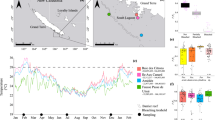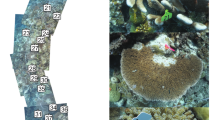Abstract
Seven zooxanthellae-free species of octocorals (the genera Acanthogorgia, Acabaria, Chironephthya, Echinogorgia, Menella, Ellisella, and Bebryce) and two zooxanthellate octocorals (the genera Paralemnalia and Rumphella) were examined to elucidate their fatty acid (FA) composition. Arachidonic (about 40% of the total FA) and palmitic acids were predominant in all the species studied. Seven furan FA (F-acids) (up to 9.7%) were identified in the azooxanthellate octocorals. The main F-acids were 14,17-epoxy-15-methyldocosa-14,16-dienoic and 14,17-epoxy-15,16-dimethyldocosa-14,16-dienoic acids. In all specimens of Bebryce studeri, C25–28 demospongic FA (about 20%) were identified. These FA reflect the presence of a symbiotic sponge in B. studeri and can be used as the specific markers for other corals. A significant difference (P < 0.01) between azooxanthellate and zooxanthellate corals was found for odd-chain and methyl-branched saturated FA, 18:1n-7, and 7-Me-16:1n-10; that indicated the presence of an advanced bacterial community in azooxanthellate corals. The zooxanthellate species were distinguished by significant amounts of 18:3n-6, 18:4n-3, and 16:2n-7 acids, which are proposed as the markers of zooxanthellae in soft corals. Contrary to the normal level of 24:5n-6 (9.4%) and 22:4n-6 (0.6%), unexpected low concentrations of 24:5n-6 (0.4%) accompanied by a high content of 22:4n-6 (up to 11.9%) were detected in some specimens. The presence of an unknown factor in octocorals, specific for n-6 PUFA, which inhibited elongation of 22:4n-6 to 24:4n-6, is conjectured.


Similar content being viewed by others
Abbreviations
- ECL:
-
Equivalent chain length
- F-acids:
-
Furan fatty acids
- FA:
-
Fatty acids
- FAME:
-
Fatty acid methyl esters
- GC:
-
Gas chromatography
- GC–MS:
-
Gas chromatography–mass spectrometry
- PUFA:
-
Polyunsaturated fatty acids
- TLC:
-
Thin-layer chromatography
- VLC:
-
Very-long-chain
References
Sorokin YI (1993) Coral reef ecology. Springer, Berlin Heidelberg New York
Ayukai T (1995) Retention of phytoplankton and planktonic microbes on coral reefs within the Great Barrier Reef, Australia. Coral Reefs 14:141–147
Fabricius KE, Dommisse M (2000) Depletion of suspended particulate matter over coastal reef communities dominated by zooxanthellate soft corals. Mar Ecol Prog Ser 196:157–167
Muscatine L, Weis V (1992) Productivity of zooxanthellae and biochemical cycles. In: Falkowski PG, Woodhead AD (eds) Primary productivity and biogeochemical cycles in the sea - Environmental Science Research, Plenum, New York, pp 257–271
Schlichter D, Kampmann H, Conrady S (1997) Trophic potential and photoecology of endolithic algae living within coral skeletons. Mar Ecol 18:299–317
Rohver F, Breitbart M, Jara J, Azam F, Knowlton N (2001) Diversity of bacteria associated with the Caribbean coral Montastraea franksi. Coral Reefs 20:85–91
Beleneva IA, Dautova TI, Zhukova NV (2005) Characterization of communities of heterotrophic bacteria associated with healthy and diseased corals in Nha Trang Bay (Vietnam). Russ J Microbiol 74:579–587
Zhukova NV, Titlyanov EA (2003) Fatty acid variations in symbiotic dinoflagellates from Okinawan corals. Phytochemistry 62:191–195
Harland AD, Fixter LM, Davies PS, Anderson RA (1991) Distribution of lipids between the zooxanthellae and animal compartment in the symbiotic sea anemone Anemonia viridis—wax esters, triglycerides and fatty acids. Mar Biol 110:13–19
Harland AD, Navarro JC, Davies PS, Fixter LM (1993) Lipids of some Caribbean and Red Sea corals—total lipid, wax esters, triglycerides and fatty acids. Mar Biol 117:113–117
Al Moghrabi S, Allemand D, Couret JM, Jaubert J (1995) Fatty acids of the scleractinian coral Galaxea fascicularis—effect of light and feeding. J Comp Physiol B 165:183–192
Ward S (1995) Two patterns of energy allocation for growth, reproduction and lipid storage in the scleractinian coral Pocillopora damicornis. Coral Reefs 17:87–90
Papina M, Meziane T, van Woesik R (2003) Symbiotic zooxanthellae provide the host-coral Montipora digitata with polyunsaturated fatty acids. Comp Biochem Physiol B 135:533–537
Widdig A, Schlichter D (2001) Phytoplankton: a significant trophic source for soft corals? Helgol Mar Res 55:198–211
Imbs AB, Demidkova DA, Latypov YY, Pham QL (2007) Application of fatty acids for chemotaxonomy of reef-building corals. Lipids 42:1035–1046
Luu VH, Doan LP, Pham QL, Imbs AB (2005) Fatty acids as chemotaxonomy of Vietnamese coral. Vietnam J Sci Technol 43:92–100
Joseph JD (1979) Lipid composition of marine and estuarine invertebrates: Porifera and Cnidaria. Prog Lipid Res 18:1–30
Lam CN, Nguen HK, Stekhov VB, Svetashev VI (1981) Phospholipids and fatty acids of soft corals. Russ J Mar Biol 6:44–47
Vysotskii MV, Svetashev VI (1991) Identification, isolation and characterization of tetracosapolyenoic acids in lipids of marine coelenterates. Biochim Biophys Acta 1083:161–165
Carballeira NM, Miranda C, Rodriguez AD (2002) Phospholipid fatty acid composition of Gorgonia mariae and Gorgonia ventalina. Comp Biochem Physiol B 131:83–87
Yamashiro H, Oku H, Higa H, Chinen I, Sakai K (1999) Composition of lipids, fatty acids and sterols in Okinawan corals. Comp Biochem Physiol B 122:397–407
Imbs AB, Demina OA, Demidkova DA (2006) Lipid class and fatty acid composition of the boreal soft coral Gersemia rubiformis. Lipids 41:721–725
Imbs AB, Luu HV, Pham LQ (2007) Intra- and interspecific variability of fatty acid composition of the soft corals. Russ J Mar Biol 33:70–73
Imbs AB, Latyshev NA, Zhukova NV, Dautova TN (2007) Comparison of fatty acid compositions of azooxanthellate Dendronephthya and zooxanthellate soft coral species. Comp Biochem Physiol B 148:314–321
Bishop DG, Kenrick JR (1980) Fatty acid composition of symbiotic zooxanthellae in relation to their hosts. Lipids 15:799–804
Svetashev VI, Vysotsky MV (1998) Fatty acids of Heliopora coerulea and chemotaxonomic significance of tetracosapolyenoic acids in coelenterates. Comp Biochem Physiol B 119:73–75
Sprecher H (2000) Metabolism of highly unsaturated n-3 and n-6 fatty acids. Biochem Biophys Acta 1486:219–231
McKenzie JD, Black KD, Kelly MS, Newton LC, Handley LL, Scrimgeour CM, Raven JA, Henderson RJ (2000) Comparisons of fatty acid and stable isotope ratios in symbiotic and non-symbiotic brittlestars from Oban Bay, Scotland. J Mar Biol Ass UK 80:311–320
Berge J-P, Barnathan G (2005) Fatty acids from lipids of marine organisms: molecular biodiversity, roles as biomarkers, biologically active compounds, and economical aspects. Mar Biotech I Adv Biochem Eng 96:49–125
Carreau JP, Dubacq JP (1979) Adaptation of macro-scale method to the micro-scale for fatty acid methyl transesterification of biological lipid extracts. J Chromatogr 151:384–390
Andersson BA (1978) Mass spectrometry of fatty acid pyrrolidides. Prog Chem Fats Other Lipids 16:279–308
Christie WW (1988) Equivalent chain lengths of methyl ester derivatives of fatty acids on gas chromatography—a reappraisal. J Chromatogr 447:305–314
Fabricius C, Alderslade P (2001) Soft corals and sea fans: a comprehensive guide to the tropical shallow water genera of the Central-West Pacific, the Indian Ocean and the Red Sea. Australian Institute of Marine Science, Townsville
Shirasaka N, Nishi K, Shimizu S (1995) Occurrence of a furan fatty acid in marine bacteria. Boichem Biophys Acta 1258:225–227
Dembitsky VM, Rezanka T (1996) Furan fatty acids of some brackish invertebrates from the Caspian Sea. Comp Biochem Physiol B 114:317–320
Rontani J-F, Christodoulou S, Koblizek M (2005) GC–MS structural characterization of fatty acids from marine aerobic anoxygenic phototrophic bacteria. Lipids 40:97–108
Carballeira NM, Maldonado L (1986) Identification of 5, 9-hexadecadienoic acid in the marine sponge Chondrilla nucula. Lipids 21:470–471
Carballeira NM, Shalabi F (1994) Unusual lipids in the Caribbean sponges Amphimedon viridis and Desmapsamma anchorata. J Nat Prod 57:1152–1159
Imbs AB, Maliotin AN, Luu VH, Pham QL (2005) Study of fatty acid composition of 17 coral species of Vietnam. Vietnam J Sci Tech 43:84–91
Miralles J, Barnathan G, Galonnier R, Sall T, Samb A, Gaydou EM, Kornprobst JM (1995) New branched chain fatty acids from the Senegalese gorgonian Leptogorgia piccola (white and yellow morphs). Lipids 30:459–466
Volkman JK, Barrett SM, Blackburn SI, Mansour MP, Sikes EL, Gelin F (1998) Microalgal biomarkers: a review of recent research developments. Org Geochem 29:1163–1179
Pereira SL, Leonard AE, Mukerji P (2003) Recent advances in the study of fatty acid desaturases from animals and lower eukaryotes. Prostaglandins Leukot Essent Fat Acids 68:97–106
Dalsgaard J, John MS, Kattner G, Muller-Navarra D, Hagen W (2003) Fatty acid trophic markers in the pelagic marine environment. Adv Mar Biol 46:225–340
Sorokin YI (1973) Trophical role of bacteria in the ecosystem of the coral reef. Nature 242:415–417
Santavy DL (1995) The diversity of microorganisms associated with marine invertebrates and their roles in the maintenance of ecosystems. CAB International, Wallingford, pp 211–229
Kaneda T (1991) Iso-fatty and anteiso-fatty acids in bacteria-biosynthesis, function, and taxonomic significance. Microbiol Rev 55:288–302
Spiteller G (2005) Furan fatty acids: occurrence, synthesis, and reactions. Are furan fatty acids responsible for the cardioprotective effects of a fish diet? Lipids 40:755–771
Groweiss A, Kashman Y (1978) A new furanoid acid from the soft corals Sarcophyton glaucum and S. gemmatum. Experimentia 34:299
Bergquist PR, Lawson MP, Lavis A, Cambie RC (1984) Fatty acid composition and the classification of the Porifera. Biochem Syst Ecol 12:63–84
Muscatine L, Gates RD, La Fontaine I (1994) Do symbiotic dinoflagellates secrete lipid droplets? Limnol Oceanogr 39:925–929
Latyshev NA, Naumenko NV, Svetashev VI, Latypov YY (1991) Fatty acids of reef-building corals. Mar Ecol Prog Ser 76:295–301
Bachok Z, Mfilinge P, Tsuchiya M (2006) Characterization of fatty acid composition in healthy and bleached corals from Okinawa, Japan. Coral Reefs 25:545–554
Tchernov D, Gorbunov MY, de Vargas C, Yadav SN, Milligan AJ, Haggblom M, Falkowski PG (2004) Membrane lipids of symbiotic algae are diagnostic of sensitivity to thermal bleaching in corals. Proc Natl Acad Sci 101:13531–13535
Fabricius KE, Mieog JC, Colin PL, Idip D, van Oppen MJH (2004) Identity and diversity of coral endosymbionts (zooxanthellae) from three Palauan reefs with contrasting bleaching, temperature and shading histories. Mol Ecol 13:2445–2458
van Oppen MJH, Mieog JC, Sanchez CA, Fabricius KE (2005) Diversity of algal endosymbionts (zooxanthellae) in octocorals: the roles of geography and host relationships. Mol Ecol 14:2403–2417
Mansour MP, Volkman JK, Jackson AE, Blackburn SI (1999) The fatty acid and sterol composition of five marine dinoflagellates. J Phycol 35:710–720
Acknowledgment
This work was supported by the grant 07-03-90001-Viet from the Russian Foundation for Basic Research.
Author information
Authors and Affiliations
Corresponding author
About this article
Cite this article
Imbs, A.B., Demidkova, D.A., Dautova, T.N. et al. Fatty Acid Biomarkers of Symbionts and Unusual Inhibition of Tetracosapolyenoic Acid Biosynthesis in Corals (Octocorallia). Lipids 44, 325–335 (2009). https://doi.org/10.1007/s11745-008-3266-2
Received:
Accepted:
Published:
Issue Date:
DOI: https://doi.org/10.1007/s11745-008-3266-2




